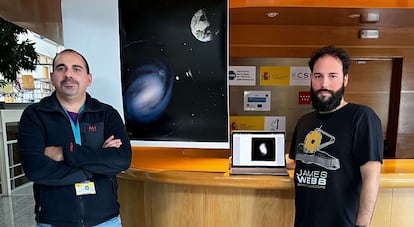Key Takeaways:
- Astrophysicist Luca Costantin discovered ceers-2112, a distant Milky Way “twin,” during his vacation.
- The James Webb Space Telescope revealed that Milky Way-like galaxies existed 11.7 billion years ago.
- This discovery gives scientists a view of the Milky Way’s early structure, including a bar-shaped core.
- Ceers-2112 shows characteristics similar to the Milky Way’s, such as a central bar that supports star formation.
- Scientists hope this discovery will reveal more about the evolution and early structure of galaxies like ours.
_______________
Ceers-2112 may reveal how galaxies like ours formed life-essential elements in the early universe.

A Glimpse into the Distant Past: Discovering Ceers-2112
Astrophysicist Luca Costantin’s latest discovery sheds light on one of astronomy’s long-standing mysteries: the formation and early structure of galaxies like our Milky Way. During his vacation to Spain, Costantin was examining recent images captured by the James Webb Space Telescope (JWST) when he identified a distant Milky Way “twin” galaxy known as ceers-2112. This groundbreaking discovery, which has now been published in Nature, unveils new insights into the early universe, allowing scientists to peer 11.7 billion years back in time.
The Discovery of a Milky Way “Twin”
The JWST, launched in December 2021, has enabled scientists to observe galaxies from the early universe with unparalleled clarity. Ceers-2112 was found in a region between the constellations Ursa Major and Bootes, where it appeared as a faint structure containing characteristics surprisingly similar to our galaxy, including a massive bar-shaped core. The stars within ceers-2112 hold about 3.9 billion solar masses, aligning with what simulations estimate the Milky Way would have looked like at that time. To astrophysicists like Pablo G. Pérez González, another study co-author, this discovery is akin to finding a young self-portrait of our galaxy from an early stage in the universe.
The Milky Way, like many nearby spiral galaxies, developed a bar in its center later in its evolutionary journey. In modern galaxies, these bar structures play an essential role, serving as areas for gas accumulation and star formation, essential for fostering life. Ceers-2112’s age—about 2.1 billion years at the time its light reached Earth—shows that it had a similar bar, supporting the idea that these structures existed in the infancy of galaxies, which was once thought unlikely. Mexican astrophysicist Yetli Rosas Guevara, who works on cosmological simulations, commented that this is the first discovery to show such spiral galaxies with bars at such an early cosmic age, a finding that opens up many possibilities about how galaxies evolved.
Implications for Understanding Galaxy Evolution
Before this discovery, scientists had limited knowledge about the formation of galaxies with bars in the early universe. In the past, telescopes like Hubble allowed astronomers to observe around 2,000 Milky Way-like galaxies, but only those that were relatively close to us. JWST’s capabilities have changed that, enabling researchers to peer into much earlier stages of the universe’s history.

Three years prior, another potential Milky Way “twin” was discovered, named SPT0418-47, but this one lacked a bar structure. Researchers believe each of these “twins” could represent different points in the Milky Way’s evolutionary timeline, potentially creating a cosmic “family album” that reveals the changes our galaxy has undergone. As further observations of ceers-2112 and other distant galaxies continue, scientists aim to confirm whether bar structures were more common in early galaxies than previously thought or if ceers-2112 represents a rare case in the cosmos.
This groundbreaking discovery by Costantin and his team represents not only a step forward in understanding our galaxy’s history but also a broader understanding of how life-essential elements were spread across galaxies. Researchers eagerly await further data from JWST to see if ceers-2112 is part of a larger group of Milky Way-like galaxies or a unique relic of the cosmos.





login situs slot gacor terpercaya sekarang juga hanya di username situs yang sudah kami berikan,
slot gacor adalah situs slot gacor hari ini dengan minimal deposit 10 ribu sudah bisa menikmati permainan slot gacor gampang menang.